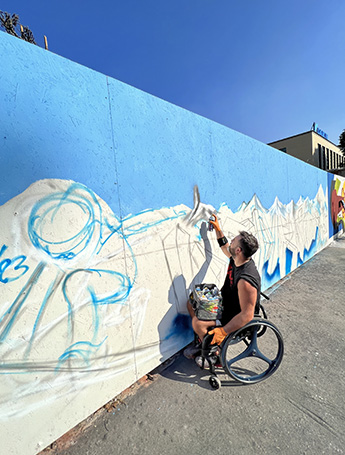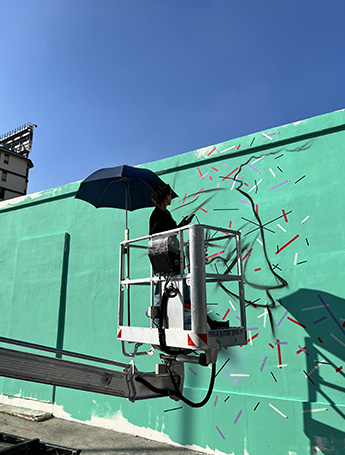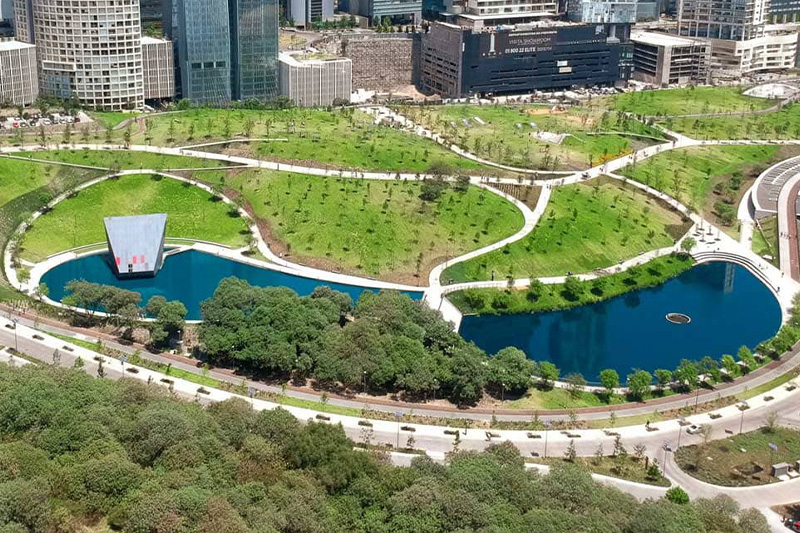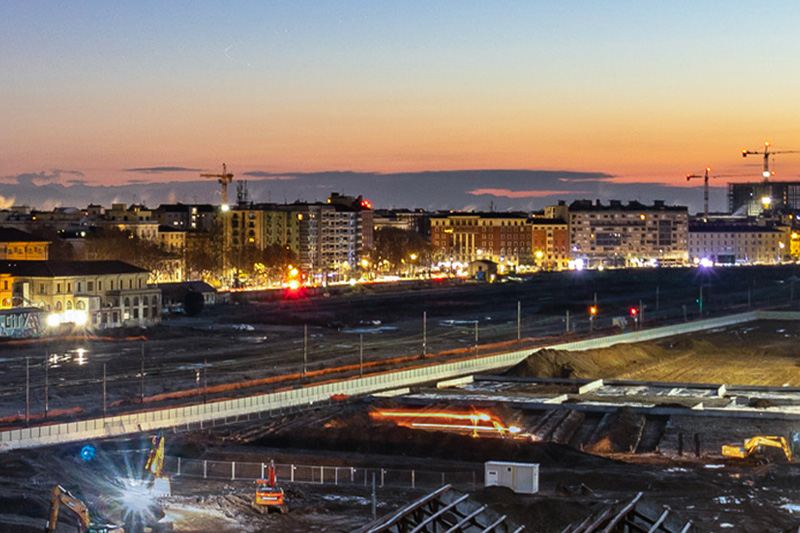Some human activities can be a language with the power to reach everyone; sports and art are certainly among them.
This is the motto of SCALOdARTS, the urban art project that has been realised in the former Porta Romana rail yard of Milan. Since 2022, this location has been undergoing significant renovation works for the creation of the Olympic Village which will welcome all the athletes and delegations participating in the Milan-Cortina 2026 Olympic and Paralympic Winter Games.
An important project that the Fondo di Porta Romana and the Municipality of Milan have entrusted to Brand for the City, an urban regeneration company which offers its services to other companies aiming to transform urban areas from places that divide into places that unite and create a community. Brand for the City has chosen to use art as a catalyst for the transformation, stimulating reflection on its importance in present and future urban regeneration projects.
To learn about the scope of the project and the role that urban art can play in the redevelopment of Italian cities, Urban Stories has met up with Claudio Bertona, CEO of Brand for the City, and some of the artists who were involved in the project. Their thoughts were compared to the opinion of Luca Borriello, Director of Inward – Osservatorio Nazionale sulla Creatività Urbana, an organisation which carries out research and development activities in the field of urban creativity, and applies its own valorisation model to the public, private and non-profit sectors.

The artist Kasy23 works in a wheelchair, a condition
that has prompted him to further innovate his art.
Luca Borriello’s own reflections offer interesting insights which help understand the model common to all urban art projects: “In this rapidly evolving world, urban creativity has the power to reach people directly, represent diversity and stimulate thinking”. A project such as SCALOdARTS is not a simple renovation project to “embellish” a public space, but instead was launched with the aim of stimulating reflection on both citizens and visitors of this city.
“Our idea with SCALOdARTS was to create something that represented the true essence of Milan”, says Claudio Bertona of Brand for the City. “We wanted to celebrate the diversity and value of Olympic ideals with art installations in an important area of the city”. This area has historically been the core of Milan’s industrialisation (for example, Tecnomasio Italiano, a key company in the development of electrification technology and transport in Italy was based here) and today is ready to become the centre of a new way of living the city with sports, education and culture as its main elements.
Read also: A sustainability and inclusion model
“In this project, we were particularly attentive to the requests of the client, who asked us to bring together a diverse group of artists, all with different styles and ideas. We asked each one of them to create a representation of the Olympic and Paralympic values according to their own personal interpretation. To achieve our goals, we decided to collaborate with Stradedarts, an association based in Milan that has been promoting street art culture for almost 25 years. Because of the distinctiveness of all the artists involved, the final result includes various artistic styles from writing to mosaics, from lettering to cartoon, from spray painting to brush painting. This way we were able to offer people a complete view of the multi-faceted world of urban art”, Bertona said.
SCALOdARTS is a project capable of giving visibility to all the different aspects of urban art, which has not been able to find its place yet in the field of figurative arts. Luca Borriello added: “Urban creativity is an umbrella term which includes various forms of art such as graffiti, street art, and new muralism. Visual and performative cultures that today, after a long period when they frequently were the object of disinformation campaigns—and sometimes even demonised—they are finally gaining popularity and the approval, not only of the public, but also of administrations and the media. Their newly acquired visibility comes together with renewed maturity of artistic gestures and creations, but also in particular, the lives, ideas and careers of the artists involved”.
The decision to carry out an urban art project in the Porta Romana district is perfectly in line with the concept of urban regeneration which COIMA promotes: art which tells a story and engages its audience, representing and promoting the Olympic and Paralympic values of excellence, friendship, respect and inclusion, as well as expressing the cultural and creative diversity of Milan, and narrating the history and evolution of the city.
Read also: Social bridges for inclusive cities
Thinking about the vision of the project, Claudio Bertona added: “The artists covered the entire perimeter walls of the Village under construction at Porta Romana with their artworks. This collective session lasted three days and during that time, everyone had the opportunity to appreciate and admire the creativity of our 20 artists (SteReal, Napal, Coquelicot, Dada, Luna, Mr. Pollo, Encs18, Frode, Kasy23, Nais, Refreshink, Tackle Zero, Wiz Art, Rancy, Octofly, Teatro, Impossibile, Ale Senso, Kiv e Robico”.

Artist SteReal works on her 'Dragonfly' artwork
inspired by the Olympic and Paralympic values
Commitment, Determination, Courage and Individual
Expression
Two main lines of thought can be identified in the ideas of the artists: the first is that Olympic and Paralympic ideals (peace, inclusivity, justice, human rights, commitment, courage, and equality) are included in their art as “elements capable of representing all aspects of life”—to use the words of ENCS18 whose installation was dedicated to short-track speed skating. He said, “It is a sport that has always captivated my interest. You need to be at the best of your mental and physical abilities. We can compare it to the life experiences of each of us, where with strength, commitment and perseverance, you can still reach your goals despite failures”.
Also Nais chose a sport performed on ice, figure skating: “I believe that the most essential value of sport is sharing. This is increasingly important today when young people tend to be more reserved and isolate themselves from society. It is for this reason that I decided to portray two ice skaters. I let my imagination get carried away by their dancing and the sense of tranquillity that they emanate, and this is exactly the feeling that I would like to transmit to those who see my work”. According to the Milanese artist, involving the people who live in the areas that are object of urban regeneration plans is precisely one of the major contributions street art can offer to contemporary cities: “Art must be a means to the re‑appropriation of public space by citizens, especially in those areas that, for various reasons, have not found their own identity yet”.
Just like Nais’ ice skaters who leave behind them a trail of peace, also Iconosaik chose to work on this concept: “my idea was to reinterpret Picasso’s ‘War and Peace’ to stress the importance of unity and mutual understanding, with the aim of provoking thought in those who happen to walk in front of my work”. A bright mosaic where the Olympic flag is depicted as four figures embracing around the dove of peace. “I think that someone who is into urban art, graffiti and street art should be first of all an artist, a professional who collaborates with public administrations and companies: we cannot offer remedies or make things right, but we can collaborate on larger projects and help promote the involvement of the people who live in these places”, Iconosaik concluded.
Coquelicot, an Italian-French artist who chose the concepts of trust, peace, joy, courage as the theme of her work, is also of the same opinion. According to her, “the artistic redevelopment of a district acquires more sense if it is done with longer deadlines, treating it as a long-term project rather than an event. Only this way, the artist and the client can initiate a dialogue with the community that will ultimately benefit the most from the renovation”.
Discover all the artworks directly introduced by the artists
What can be learnt from the artists’ words is that the contribution of street art and urban art to the urban regeneration of Italian cities must come—as it happens with real estate projects—from the analysis and survey of the area in which it takes place. “Street art is a spontaneous and sincere form of artistic expression”, Claudio Bertona said. “But it can also promote attention, identity and recognition. It is first of all urban regeneration as its objective is the re-appropriation and transformation of the identity of a place, but it can also contribute to strengthening people’s sense of identity, turning an area into a place capable of uniting and creating a sense of community”. For this reason, Bertona added: “we are confident that all the artworks created for SCALOdARTS are destined to last and that they will continue to embellish the district long after the Olympic Village has been built and has completed its function”.
Read also: A district that creates value
This is the message that SCALOdARTS wants to convey at Porta Romana, three years before the start of the Olympic Games: urban art can be fully understood over the long period, as only with the passing of time, its values and the emotions it arises can be consolidated, questioned and re-discussed.
Luca Borriello stated: “the ultimate goal of all artists and cultural officers who have been involved in the most effective examples of urban creativity (for example, our Mural Park in Naples, the MAU museum of urban art in Turin, the Fate Lab San Potito Art in San Potito Sannitico in the province of Caserta, the Borgo Vecchio Factory in Palermo, the SuperWalls near Padua and Farm Cultural Park in Favara near Agrigento) is that buildings and infrastructures are not the only things that undergo a transformation; this change and regeneration involves in particular the souls and lives of those who live there, who spend their time there or even pass by, and are touched by an invisible, impudent force—the energy of art in public spaces, which provokes critical thinking, invites action and raises consciences”.




